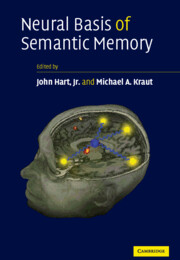Book contents
- Frontmatter
- Contents
- List of contributors
- Preface
- Part I Semantic Memory: Building Models from Lesions
- Part II Insights from Electrophysiology
- 3 Functional modularity of semantic memory revealed by event-related brain potentials
- 4 Bilingual semantic memory revisited – ERP and fMRI evidence
- Part III Applications of Models to Understanding Cognitive Dysfunction
- Part IV Representations of Nouns and Verbs vs. Objects and Actions
- Part V Critical Role of Subcortical Nuclei in Semantic Functions
- Part VI Conceptual Models of Semantics
- Index
- References
3 - Functional modularity of semantic memory revealed by event-related brain potentials
from Part II - Insights from Electrophysiology
Published online by Cambridge University Press: 14 September 2009
- Frontmatter
- Contents
- List of contributors
- Preface
- Part I Semantic Memory: Building Models from Lesions
- Part II Insights from Electrophysiology
- 3 Functional modularity of semantic memory revealed by event-related brain potentials
- 4 Bilingual semantic memory revisited – ERP and fMRI evidence
- Part III Applications of Models to Understanding Cognitive Dysfunction
- Part IV Representations of Nouns and Verbs vs. Objects and Actions
- Part V Critical Role of Subcortical Nuclei in Semantic Functions
- Part VI Conceptual Models of Semantics
- Index
- References
Summary
Theorists have faced a lack of consensus about basic properties of mind and brain. Of these basic properties, perhaps the most important is whether mind and brain are best conceived of as consisting of a number of independently functioning processing modules (e.g. Donders, 1868; Posner & Raichle, 1994; Sternberg, 1969, 1998, 2001), or rather as a single entity consisting of a large number of massively interacting parts (e.g. Anderson, 1995; Rumelhart, McClelland, & the PDP Research Group, 1986). Answering this question is extremely important, because the answer necessarily directs the course of both theory construction and experimentation in cognitive psychology and cognitive neuroscience, and the study of semantic memory in particular.
As a contribution toward clarifying this issue, this chapter demonstrates how event-related potentials (ERPs) can be used to detect, isolate, and analyze functional neural modules, with special attention to functional modularity in semantic information processing. The method and analyses described in this chapter are also applicable to the closely related technique of magnetoencephalography (MEG; Hämäläinen, Hari, Ilmoniemi, Knuutila, & Lounasmaa, 1993), as well as to ERPs. The approach described here is based on a well-known physical property of electric fields in a volume conductor such as the brain, namely, that electric fields generated by separate sources combine by summation (Kutas & Dale, 1997; Nunez, 1981, 1990). Expanding on earlier work (Kounios, 1996; see also Kounios & Holcomb, 1992; Sternberg, 2001), this chapter shows how factorial experimental design can enable independent manipulation of these separate sources, yielding additive contributions to the aggregate electric field detectable at the scalp.
Keywords
- Type
- Chapter
- Information
- Neural Basis of Semantic Memory , pp. 65 - 104Publisher: Cambridge University PressPrint publication year: 2007
References
- 2
- Cited by



